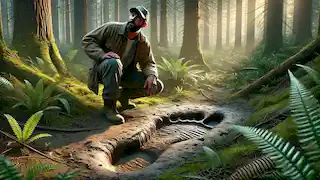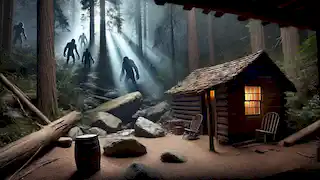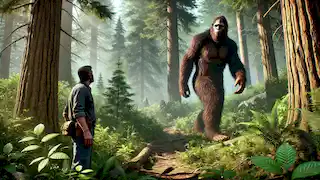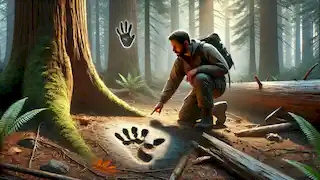The Legend of Bigfoot
Reading Time: 10 min

About Story: The Legend of Bigfoot is a Legend from united-states set in the Contemporary. This Conversational tale explores themes of Nature and is suitable for All Ages. It offers Cultural insights. An enduring mystery of the wild, where folklore meets modern-day intrigue.
Introduction
The Legend of Bigfoot is one of the most enduring and fascinating cryptozoological mysteries in the United States. Stories of a large, hairy, ape-like creature roaming the wilderness have circulated for centuries, drawing from Native American folklore, early settler accounts, and modern-day sightings. Known by many names—Sasquatch, Yeti, Skunk Ape—Bigfoot has captivated imaginations across North America. Some see Bigfoot as a relic of a prehistoric time, while others believe it to be a myth born from misunderstandings and misidentifications. However, for those who have claimed to have encountered the creature firsthand, Bigfoot is far more than a legend.
This story takes you deep into the woods of the Pacific Northwest, where the legend of Bigfoot is strongest. We'll explore the history, the evidence, and the mystery that continues to surround this elusive being.
The Origins of the Legend
The legend of Bigfoot is deeply rooted in Native American folklore. Tribes from different regions have long told stories of giant, hairy beings that lived in the forests and mountains. The most well-known of these tribes, the Salish, who inhabited parts of what is now British Columbia and Washington state, spoke of "Sasq'ets," a creature whose name would eventually evolve into "Sasquatch."
According to Salish tradition, Sasquatch was a protector of the forest, a guardian spirit who lived in harmony with nature. Unlike the fearsome creatures described in modern accounts, these early stories often portrayed Sasquatch as a benign figure—aloof and elusive, but not threatening to humans unless provoked. However, other tribes had more ominous interpretations. The Hoopa tribe of northern California, for instance, warned of "hairy men" who could be both dangerous and powerful.
European settlers arriving in the 18th and 19th centuries encountered these stories and soon began contributing their own tales. Explorers and trappers reported sightings of massive footprints and strange howls echoing through the wilderness. These early accounts marked the beginning of the Bigfoot legend as we know it today.
In 1884, one of the first documented encounters with a creature resembling Bigfoot occurred near Yale, British Columbia. Local newspapers reported the capture of a wild man called "Jacko." Although many believed this to be a sensationalized hoax, the story added fuel to the growing fascination with the creature.
The Modern Bigfoot Phenomenon
The modern era of Bigfoot began in 1958 when a man named Jerry Crew discovered a series of massive footprints near Bluff Creek, California. These prints, measuring 16 inches long, were unlike anything Crew had ever seen. He took casts of the tracks and presented them to a local newspaper, which ran the story under the headline, "Giant Footprints Puzzle Residents." Thus, the name "Bigfoot" was born.
Crew's discovery sparked a wave of interest that swept across the country. Reports of Bigfoot sightings flooded in, not just from the Pacific Northwest but from as far afield as Florida, where the creature was dubbed the "Skunk Ape" due to its foul odor. Hunters, campers, and hikers began claiming they had seen the massive, bipedal creature or heard its eerie, guttural calls in the dead of night.
Perhaps the most famous piece of Bigfoot evidence came in 1967 with the release of the Patterson-Gimlin film. Shot near Bluff Creek, the grainy footage appeared to show a female Bigfoot walking through a clearing before glancing back at the camera. Despite decades of analysis and debate, the authenticity of the footage remains inconclusive.
Nonetheless, the film cemented Bigfoot's place in popular culture. Television shows, documentaries, and books explored the legend, each offering new theories and evidence. Cryptozoologists—the scientists who study unknown or undiscovered animals—took an interest in Bigfoot, collecting casts of footprints, hair samples, and recordings of what they believed were Bigfoot vocalizations. Although mainstream scientists remained skeptical, the fascination with Bigfoot only grew stronger.
The Bigfoot Hunt
For many, the allure of Bigfoot lies in the possibility that there may still be something out there—something hidden in the vast, uncharted wilderness of North America. In the years since Crew's discovery, countless expeditions have ventured into the deep forests of the Pacific Northwest, hoping to catch a glimpse of the elusive creature.
Some researchers have dedicated their lives to proving the existence of Bigfoot. One such individual is Dr. Grover Krantz, a physical anthropologist who spent decades studying Bigfoot. Krantz believed that Bigfoot was a relic population of a prehistoric ape called *Gigantopithecus*, a species known to have lived in Asia. He argued that these creatures could have crossed the Bering land bridge into North America during the last Ice Age and that small populations might still exist in remote areas.
Krantz's work, along with the efforts of other Bigfoot enthusiasts, helped shape the modern search for the creature. Armed with motion-sensor cameras, sound recording equipment, and night-vision goggles, these researchers venture into the woods, hoping to capture definitive proof of Bigfoot's existence.
Despite numerous reported sightings and encounters, hard evidence has remained elusive. Many photos and videos purportedly showing Bigfoot have been debunked as hoaxes, while footprints and hair samples have often turned out to belong to known animals such as bears or humans. Nonetheless, believers remain undeterred, convinced that the truth is out there, waiting to be discovered.

Famous Encounters
While many Bigfoot sightings are fleeting glimpses or brief auditory encounters, some stand out for their detail and intensity. These encounters have fueled the ongoing belief in the creature and have become part of Bigfoot lore.
One of the most famous encounters occurred in 1924 near Ape Canyon, Washington. A group of prospectors reported being attacked by a group of "mountain devils" after they had fired upon a creature they saw watching them from the treeline. According to the men, the creatures hurled rocks at their cabin throughout the night, trying to break in. By morning, the creatures had disappeared, leaving behind only large footprints in the dirt. This story, passed down through generations, remains one of the most well-known Bigfoot encounters in history.
In 1971, a man named William Roe claimed to have had a close encounter with a Bigfoot while hiking near Mica Mountain, British Columbia. Roe's account is notable for its vivid detail—he described the creature as standing 6 feet tall, covered in dark brown hair, and having a human-like face. He watched the creature from a distance for several minutes before it calmly walked away into the forest.
Another famous sighting occurred in 1982 when Paul Freeman, a U.S. Forest Service worker, stumbled upon a series of large footprints in the Blue Mountains of Washington. Freeman's find, which included handprints and a series of plaster casts, reignited interest in Bigfoot research. Freeman himself became a prominent figure in the Bigfoot community, claiming to have seen the creature several times over the years.
These encounters, along with thousands of others reported across the country, continue to fuel the legend of Bigfoot. Whether these witnesses truly encountered a living creature or misinterpreted their surroundings remains a matter of debate.

Skepticism and Criticism
While the legend of Bigfoot has many believers, it also has its fair share of skeptics. The scientific community, in particular, has largely dismissed the idea of Bigfoot, citing the lack of physical evidence as the primary reason for their disbelief.
Skeptics argue that if a population of large, bipedal creatures existed, they would leave behind more concrete evidence, such as bones or fossils. They also point to the fact that many supposed Bigfoot sightings occur in areas where known animals like bears are prevalent. Bears, especially when walking on their hind legs, can appear strikingly similar to the descriptions of Bigfoot given by witnesses.
Moreover, many Bigfoot sightings and footprints have been revealed as hoaxes. One of the most famous examples is the case of Ray Wallace, a logger who, after his death in 2002, was revealed to have faked the footprints that started the Bigfoot craze in 1958. Wallace's family admitted that he had carved giant wooden feet and used them to create tracks near Bluff Creek as a prank.
Despite these revelations, believers maintain that not all evidence can be dismissed so easily. They argue that many sightings and encounters cannot be explained away as hoaxes or misidentifications, and they continue to push for further investigation.
The Enduring Mystery
What is it about Bigfoot that captures the imagination of so many? Perhaps it is the allure of the unknown, the idea that there might still be undiscovered creatures lurking in the wild places of the Earth. Or perhaps it is the connection to our own primal past—a reminder that we, too, were once wild creatures living at the mercy of nature.
Bigfoot has become more than just a creature of folklore. It is a symbol of mystery, of the untamed wilderness that still exists in parts of our world. For many, the search for Bigfoot is about more than proving the existence of a large ape-like creature. It is about holding on to the idea that there is still something left to discover.
Whether Bigfoot is a real creature or a figment of the imagination, the legend shows no signs of fading. As long as there are remote forests, strange footprints, and unexplained howls in the night, the legend of Bigfoot will endure.

The Search Continues
In recent years, technology has played a significant role in the ongoing search for
Bigfoot. Drones equipped with high-resolution cameras, thermal imaging, and other advanced tools have been deployed in areas where sightings have been reported. While these efforts have yet to yield definitive proof, they have added a new dimension to the hunt for Bigfoot.
Cryptozoologists and amateur researchers alike continue to venture into the wilderness, drawn by the promise of discovery. The allure of Bigfoot lies not only in the creature itself but in the adventure—the thrill of exploring the unknown, of searching for something elusive and mysterious.
Television shows like *Finding Bigfoot* and documentaries about the creature have kept the legend alive in popular culture. Each new piece of evidence, no matter how small, is met with excitement by believers, while skeptics remain unconvinced.
The mystery of Bigfoot may never be solved, but for those who believe, the search will go on. In the deep, dark forests of North America, the legend lives on, waiting for the next person brave enough to venture into the wild and discover the truth.

Conclusion
The legend of Bigfoot is one of America's most enduring and captivating mysteries. It weaves together elements of folklore, history, science, and imagination. Whether real or imagined, Bigfoot represents the last great frontier of the unknown. In a world where so much has been explored and explained, the possibility of an undiscovered creature still walking the forests of North America continues to inspire curiosity and wonder.
And so, the story of Bigfoot remains unfinished. Perhaps, one day, a hiker will stumble upon undeniable proof, or maybe the legend will continue to elude us, just beyond the reach of our understanding. Until then, the forests remain a place of mystery, where anything—just maybe—could still be possible.

















